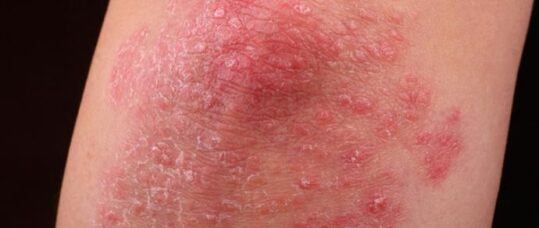Choosing the right emollients for psoriasis

Psoriasis is characterised by clearly defined, red and scaly plaques. There are several types and further information relating to the condition can be found in the resource section below.
As with many skin conditions, topical therapies are the first line treatment for many inflammatory skin conditions and psoriasis is no exception.
The NICE guideline for psoriasis focused on active topical therapies but did acknowledge that the use of emollients as an adjunct to the active therapies in psoriasis was already widespread and as a result were not included in the review.1
Related Article: Diagnosis Connect service will link people to advice from charities
The previous article on the use of emollients in eczema covers the key principles of use, which are generally applicable for psoriasis. There are in addition some key messages for their use when treating psoriasis.
Emollients are an essential and often overlooked therapy for psoriasis and should be used daily to improve dry skin associated with the condition.2
When psoriasis is very mild an emollient may be the only topical treatment required for certain periods.3 However, the therapeutic effect of emollients goes beyond just a cosmetic and comforting effect, they have anti-inflammatory properties, and they also help to:4,5,6
- Ease itching and soothe the skin, relieving the irritation and soreness.
- Reduce scaling – emollients clear superficial scale. Cosmetically, the plaques look better and they are less troublesome when dressing etc.
- Soften cracked areas.
- Assist with the penetration of other topical treatments. Scale removal also allows easier application, penetration and absorption of other active topical therapies. 30 minutes should be allowed between the application of an emollient and application other active psoriasis treatments.
- Protect the skin- well-moisturised skin will mean the skin is more supple and protected against damage; reducing the risk of skin cracks, fissures and Koebner phenomenon.
The Koebner phenomenon describes the appearance of new skin lesions on areas of cutaneous injury in otherwise healthy skin, and plaques exhibiting the Koebner phenomenon can appear on any area of the body, even those not usually involved by psoriasis.
It is not related to disease severity – occurring in mild and severe disease – and it is not related to disease activity, although it is more common in unstable psoriasis, patients who have had multiple treatments and occurs less frequently during remission. Other factors include age of onset, seasonal variations and emotional distress.7
Related Article: CVD prevention must be national health priority, says report
Emollients are useful adjuvant treatments helping to remove scaly skin, which may make treatment more difficult. A more supple skin is more comfortable for the patient and also reduces the risk of skin cracks, fissuring, and the Koebner phenomenon.
In patients not responding to treatment, investigate whether they have used emollients in addition to their topical therapies.
Emollients can often potentiate a topical treatment outcome, enhancing the efficacy of other topical therapies and preventing disease exacerbation as well as alleviating irritated skin.4
References
Related Article: Postnatal contraception advice reduces the risk of back-to-back pregnancies
- NICE. CG153: Psoriasis: assessment and management. London;NICE:2017
- Van Onselen J. An overview of psoriasis and the role of emollient therapy. Br J Community Nurs 2013;18:174-9
- Hilton R. Management of psoriasis affecting high-impact sites. Dermatol Nurs 2016;15:23-7
- Gelmetti C. Therapeutic moisturizers as adjuvant therapy for psoriasis patients. Am J Clin Dermatol. 2009;10:7-12
- The Psoriasis and Psoriatic Arthritis Alliance. Emollients and Psoriasis. London;PAPAA:2016
- NICE. CKS: Psoriasis. London;NICE:2017
- Psoriasis Association. Moisturisers. Northampton;Psoriasis Association:2018
- Luo A. Koebner phenomenon. Hamilton;DermNetNZ:2016
Resources
- British Association of Dermatologists. Topical Treatments for Psoriasis bad.org.uk/for-the-public/patient-information-leaflets/psoriasis—topical-treatments
- Centre of Evidence Based Dermatology. Systematic reviews on psoriasis tinyurl.com/reviews-on-psoriasis
- DermNetNZ. Psoriasis dermnetnz.org/topics/psoriasis
- Primary Care Dermatology Society. Psoriasis: an overview and chronic plaque psoriasis pcds.org.uk/clinical-guidance/psoriasis-an-overview#aetiology
- Psoriasis Association psoriasis-association.org.uk
- The Psoriasis and Psoriatic Arthritis Alliance papaa.org

See how our symptom tool can help you make better sense of patient presentations
Click here to search a symptom


Psoriasis is a common inflammatory and proliferative disorder of the skin that affects 2.8% of the general population in the UK, with recent data identifying a steady increase in the prevalence.



